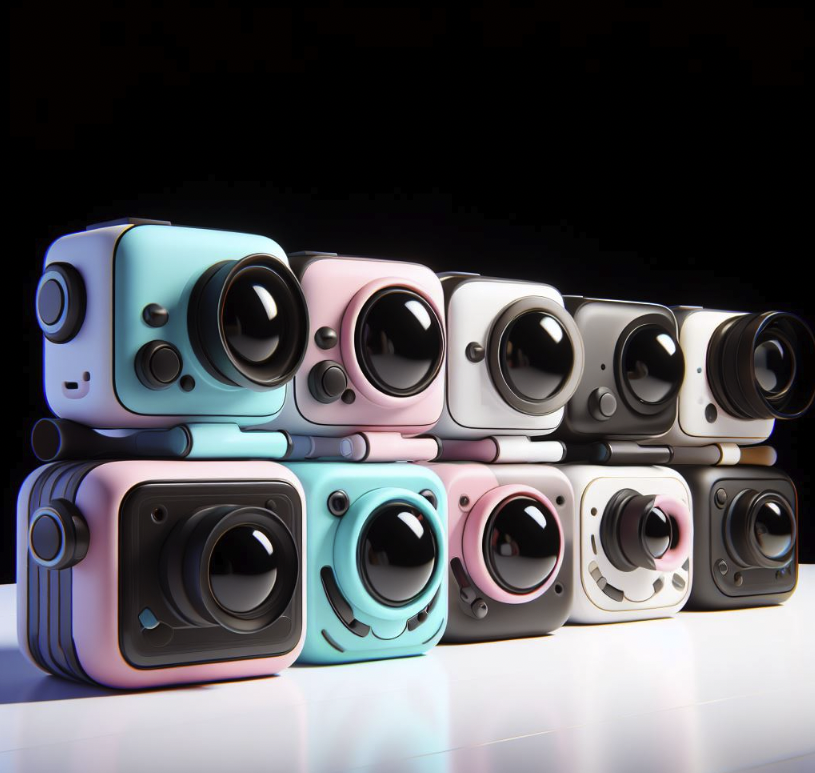When it comes to capturing moments on the go, having the right camera can make all the difference.
Action cameras and traditional cameras both have their own unique features and advantages, but which one is better suited for on-the-go photography and videography?
Action Cameras vs. Traditional Cameras
Action Cameras:
- Size: Compact and lightweight, making them easy to mount or wear.
- Durability: Often built to withstand rough conditions, including water, dust, and shocks.
- Video Focus: Typically emphasize high-quality video recording, often with impressive stabilization.
- Ease of Use: Generally simple to operate with fewer manual controls.
- Wide-Angle: Usually feature a wide-angle lens to capture more within the frame.
Traditional Cameras (DSLRs, Mirrorless, Point-and-Shoot):
- Image Quality: Tend to offer superior image quality with larger sensors and better optics.
- Versatility: Provide more control over settings like ISO, aperture, and shutter speed.
- Lens Options: Allow for interchangeable lenses (especially DSLRs and mirrorless) to adapt to different shooting scenarios.
- Size: Generally larger and heavier than action cameras.
- Durability: May require additional protective gear for extreme conditions.
Action cameras are ideal for capturing high-quality video in active, rugged, or underwater environments due to their compact and durable nature.
Traditional cameras offer superior image quality and greater control over settings, making them suitable for a wider range of photography, from portraits to landscapes.
Below we look deeper at the key differences between action cameras and traditional cameras, and provide insights to help you make an informed decision.
Table of Contents
The Rise of Action Cameras
Action cameras have gained immense popularity in recent years, thanks to their compact size, durability, and ability to capture high-quality footage in extreme conditions.
These cameras are specifically designed for capturing action-packed moments, making them ideal for outdoor enthusiasts, adventure seekers, and sports enthusiasts.
One of the most well-known action camera brands is GoPro, which revolutionized the market with its compact and rugged designs.
GoPro cameras are known for their wide-angle lenses, waterproof capabilities, and advanced stabilization features, allowing users to capture stunning footage while engaged in various activities.
The Versatility of Traditional Cameras
Traditional cameras, on the other hand, have been around for decades and have evolved to cater to a wide range of photography and videography needs.
From DSLRs (Digital Single-Lens Reflex) to mirrorless cameras, traditional cameras offer a plethora of features and options that can be customized to suit individual preferences.
Traditional cameras excel in providing superior image quality, thanks to their larger sensors and interchangeable lenses.
They offer more control over settings such as aperture, shutter speed, and ISO, allowing photographers to capture stunning still images in various lighting conditions.
Key Differences: Action Cameras vs. Traditional Cameras
Now that we have a basic understanding of action cameras and traditional cameras, let’s delve into the key differences between the two:
Size and Portability
Action cameras are designed to be compact and lightweight, making them easy to carry and mount on various surfaces.
Their small size allows users to capture footage without feeling weighed down, making them perfect for on-the-go adventures.
Traditional cameras, on the other hand, tend to be bulkier and require additional accessories such as lenses and tripods.
While they may not be as portable as action cameras, they offer more versatility in terms of lens options and manual controls.
Durability and Weather Resistance
Action cameras are built to withstand extreme conditions, including water, dust, and shock.
They are often waterproof and come with rugged housing that protects them from accidental drops and impacts.
This durability makes them ideal for capturing footage during activities such as surfing, skiing, or mountain biking.
Traditional cameras, although not as rugged as action cameras, can still be used in various weather conditions with the right precautions.
Many traditional cameras offer weather-sealing features and can be paired with weather-resistant lenses to protect them from moisture and dust.
Image and Video Quality
When it comes to image and video quality, traditional cameras generally have the upper hand.
With larger sensors and the ability to use interchangeable lenses, traditional cameras can capture more detail, produce better dynamic range, and perform well in low-light situations.
Action cameras, on the other hand, prioritize capturing wide-angle footage with a fixed lens.
While they may not offer the same level of image quality as traditional cameras, they excel in capturing immersive footage with their wide field of view.
Stabilization
One of the key advantages of action cameras is their built-in stabilization technology.
Action cameras are equipped with electronic image stabilization (EIS) or optical image stabilization (OIS) features that help reduce camera shake and produce smoother footage.
Traditional cameras also offer stabilization features, but they often require additional accessories such as gimbals or tripods to achieve similar results.
While traditional cameras may provide better overall stabilization, action cameras offer a more convenient and hassle-free solution for on-the-go shooting.
Example: Capturing Adventure with Action Cameras
To further illustrate the advantages of action cameras for on-the-go photography, let’s take a look at an example:
John is an avid mountain biker who loves capturing his adventures on camera.
He recently purchased an action camera to document his rides and share them with his friends and followers.
The action camera’s compact size and lightweight design allow John to mount it on his helmet or handlebars without hindering his movements.
During one of his rides, John encounters a challenging downhill trail with plenty of jumps and obstacles.
Thanks to the action camera’s built-in stabilization, he is able to capture smooth and immersive footage, showcasing the adrenaline-pumping experience of the ride.
Furthermore, the action camera’s waterproof capabilities allow John to capture footage even in wet and muddy conditions, without worrying about damaging the camera.
The wide-angle lens captures the breathtaking scenery as he rides through forests and streams, adding an extra layer of excitement to his videos.
FAQs – Action Cameras vs. Traditional Cameras: Which is Better for On-the-Go?
1. Can action cameras capture high-quality images like traditional cameras?
Action cameras prioritize video capture over still images, but they can still capture decent quality photos.
However, traditional cameras with larger sensors and interchangeable lenses generally offer better image quality.
2. Are action cameras suitable for professional photography?
Action cameras are primarily designed for capturing action-packed moments and are not typically used for professional photography.
Traditional cameras with their superior image quality and manual controls are better suited for professional use.
3. Can traditional cameras be used for action sports?
Traditional cameras can be used for action sports, but they may require additional accessories such as gimbals or tripods to achieve stable footage.
Action cameras, with their built-in stabilization and compact size, are more convenient for capturing action sports.
4. Do action cameras have zoom capabilities?
Most action cameras have fixed lenses and do not offer optical zoom capabilities.
However, some models may offer digital zoom, which can result in a loss of image quality.
5. Can traditional cameras be mounted on helmets or other gear?
Traditional cameras can be mounted on helmets or other gear using various mounting accessories.
However, their larger size and weight may make them less suitable for certain activities compared to action cameras.
6. Are action cameras suitable for low-light photography?
Action cameras generally struggle in low-light conditions due to their smaller sensors and fixed lenses.
Traditional cameras with larger sensors and the ability to use fast lenses perform better in low-light situations.
7. Can action cameras record in 4K resolution?
Many action cameras are capable of recording in 4K resolution, offering high-quality footage.
However, it’s important to check the specifications of each model as some may only support lower resolutions.
8. Do traditional cameras have built-in Wi-Fi and GPS like action cameras?
While some traditional cameras may have built-in Wi-Fi and GPS capabilities, it is more common to find these features in action cameras.
These features allow users to easily transfer files and track their location during their adventures.
9. Can action cameras be used for underwater photography?
Yes, many action cameras are waterproof and can be used for underwater photography.
They often come with specialized housing that allows them to be submerged to certain depths.
10. Are traditional cameras more expensive than action cameras?
Traditional cameras, especially high-end DSLRs and mirrorless cameras, can be more expensive than action cameras.
However, there are also budget-friendly options available in both categories.
Summary – Action Cameras vs. Traditional Cameras: Which is Better for On-the-Go?
Choosing between an action camera and a traditional camera for on-the-go photography depends on your specific needs and preferences.
Action cameras excel in portability, durability, and convenience, making them ideal for capturing action-packed moments during outdoor activities.
On the other hand, traditional cameras offer superior image quality, manual controls, and versatility, making them a better choice for professional photography or situations where image quality is paramount.
Ultimately, the decision comes down to the type of content you want to capture and the level of control you require.
If you prioritize convenience and immersive footage, an action camera may be the better option.
However, if you value image quality and customization, a traditional camera may be more suitable.


